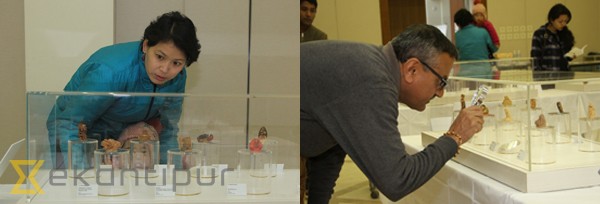Netsuke, a uniquely Japanese art tradition, comes to Kathmandu
 Abani Malla / Kathmandu : A miniature figure of a girl sits on an egg, as if warming it up to hatch like a mother hen. Her facial expressions don’t allow the viewer to decode her emotions but it’s intriguing to decide what she is up to, and just where the egg came from.
Abani Malla / Kathmandu : A miniature figure of a girl sits on an egg, as if warming it up to hatch like a mother hen. Her facial expressions don’t allow the viewer to decode her emotions but it’s intriguing to decide what she is up to, and just where the egg came from.
Rieko Otake’s netsuke titled ‘Egg’ is one among 65 other carved wooden sculptures from 46 Japanese artists currently being exhibited at the Japanese embassy in Panipokhari as part of the Japan Foundation’s “travelling exhibition.”
Netsuke are a quintessentially Japanese tradition. In the Edo period (1603-1868), these small intricately-carved wooden sculptures were meant to secure mini-containers for holding objects when wearing pocket less kimonos. However, with the influx of Western culture into Japan during the Meiji period (1868-1911), traditional clothes like kimonos started to be worn less as daily attire. Subsequently, the use of netsuke slowly started to die out with the transition to western clothing.
However, since the 70s, a generation of Japanese artists has rekindled the netsuke tradition, turning the once utilitarian objects into pieces of art. The Japan Foundation has collected a range of these contemporary netsuke to showcase globally as part of its 20 ‘travelling exhibitions’ that happen every year. The netsuke include elements from Japanese folk tales and myths, imaginary creatures, plants, and human figures.
“The Japan Foundation buys artwork from various Japanese artists and sends them to Japanese embassies all over the world to promote Japanese culture,” said Ishwori Bhatta from the Media and Culture Department at the Japanese Embassy, Kathmandu. “Before coming to Nepal, the exhibition was in Mongolia and after the exhibition ends here, we will send it to Kazakhstan.”
Although small in size, the netsuke are intricately detailed—even strands of hair in Rin Suzuki’s ‘Gorilla’ or the waves attached in Rumine Kandachi’s ‘Plover’ are meticulously carved. The exhibition has been categorised into seven sub-sections: Introduction, Legends and folklore, Imaginary creatures and deities, Plants with wood as the material, Animals, The human figure, and Special twists on classic motifs—all of which provide insights into a dedicated craftsmanship tradition that Nepalis, especially artists, could learn much from.
“We’ve had visitors from four or five schools as part of an educational tour,” said Bhatta. “We’ve even had visitors who don’t seem to understand the art and its language but for Nepali artists, it holds more value. They might find it interesting and something to take inspiration from.”
The Japan Foundation, since its establishment in 1972, has devoted itself to the education of Japanese arts, culture, and language through exchange programmes meant to deepen mutual understanding of art practices and culture globally.
The exhibition, ‘Contemporary wood-carved netsuke’, is on display at the Japanese Embassy, Panipokhari, till January 31. Courtesy: The Kathmandu Post
